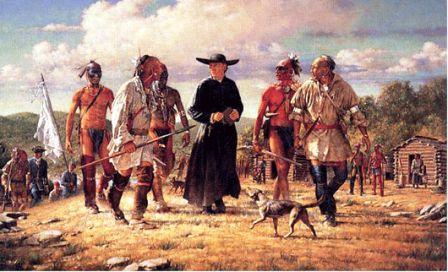The Iroquois Confederacy Constitution
The Iroquois Confederacy Constitution was also known as the "League of Peace and Power". Deganawida and Hiawatha brought about an alliance of the Iroquois tribes by bringing a message, known as the Gayanashagowa or the Great Law of Peace, to the warring Iroquoian nations. The Great Law of Peace was the basis of the Iroquois Confederacy Constitution. The Great Law of Peace or the Iroquois Confederacy Constitution is divided into 117 articles.
Iroquois Confederacy Constitution
Read about the History and Founding of the Iroquois Confederacy and discover interesting facts and information about the founders Deganawida the Great Peacemaker and his spokesman Hiawatha, the tribes of the league, where they were located with a map for reference, the People of the Longhouse, the Hiawatha Wampum Belt, the Tree of Peace, Great Law of Peace and the Great Council.
Full Text of the Iroquois Confederacy Constitution
The Constitution contained details of the organization, and function of the Iroquois League. The Constitution covered subjects including the Role of the Great Council, Council membership, Eligibility and Resignation, Candidates, Election of Pine Tree Chiefs, Names, Duties and Rights of War Chiefs, Women, Clans and Consanguinity, Official Symbolism, Wampum, Laws of Adoption, Laws of Emigration, Rights of Foreign Nations, Rights and Powers of War, Treason or Secession of a Nation, Rights of the People of the Five Nations, Religious Ceremonies Protected, Protection of the House and Funeral Addresses. The full text of the 117 Articles of the Iroquois Confederacy Constitution can be accessed via the following links:
Iroquois Confederacy Constitution: Articles 01 - 12 : Role of the Great Council
Iroquois Confederacy Constitution: Articles 13 - 19 : Council membership, Wampum
Iroquois Confederacy Constitution: Articles 20 - 26 : Eligibility and Resignation
Iroquois Confederacy Constitution: Articles 27 - 34 : Candidates
Iroquois Confederacy Constitution: Articles 35 - 54 : Election of Pine Tree Chiefs,
Names, Duties and Rights of War Chiefs, Women, Clans and Consanguinity
Iroquois Confederacy Constitution: Articles 55 - 65 : Official Symbolism and Wampum
Iroquois Confederacy Constitution: Articles 66 - 78 : Laws of Adoption, Laws of Emigration
and Rights of Foreign Nations
Iroquois Confederacy Constitution: Articles 79 - 91 : Rights and Powers of War
Iroquois Confederacy Constitution: Articles 92 - 106 : Treason or Secession of a Nation,
Rights of the People of the Five Nations, Religious Ceremonies Protected
Iroquois Confederacy Constitution: Articles 107 - 117 : Protection of the House, Funeral Addresses

Iroquois Warriors
Iroquois Confederacy Constitution and the U.S. Constitution
The democratic ideals of the Gayanashagowa (Iroquois Confederacy Constitution) provided inspiration to Benjamin Franklin, James Madison and the other great authors of the United States Constitution. Many of the articles are very similar but there is a major difference between The Great Law of Peace and the original US Constitution. This was the original denial of suffrage to women, and rule of majority as opposed to consensus in the US Constitution. The women of the Iroquois tribes exercised great influence in the government of the people. Elderly women had the right to sit in the councils and the power to exercise a veto on a declaration of war. The women were also allowed to demand a cessation of hostilities. In October 1988, the US Congress passed Concurrent Resolution 331 to recognize the influence of the Iroquois Confederacy Constitution upon the US Constitution and Bill of Rights.
Iroquois Confederacy Constitution
- The Iroquois Confederacy Constitution of Native Americans
- Text of the Articles of the Iroquois Confederacy Constitution
- Interesting facts and info for kids and schools
- Read the words of the Articles of the Iroquois Confederacy Constitution
- Native Americans pictures and videos for kids
Pictures and Videos of Native Americans
The Iroquois Confederacy Constitution. Discover the vast selection of pictures which relate to the History of Native Americans. The pictures show the clothing, war paint, weapons and decorations of various Native Indian tribes that can be used as a really useful educational history resource for kids and children of all ages. We have included pictures and videos to accompany the main topic of this section - Iroquois Confederacy Constitution. The videos enable fast access to the images, paintings and pictures together with information and many historical facts. All of the articles and pages can be accessed via the Native Indian Tribes Index - a great educational resource for kids.